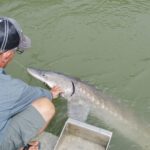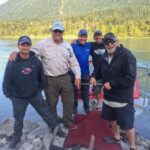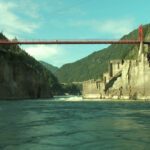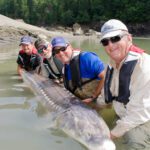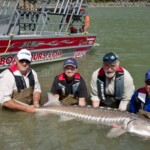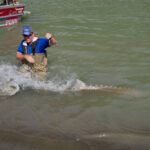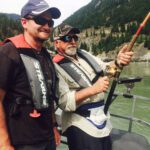THE TEN-FOOT CURSE
“If at first you don’t succeed, try and try again”, says Angelo. “And that’s exactly what we’re going to do. This episode is about trying to break the ten foot Sturgeon barrier Pete and I set for ourselves years ago. I’m talking about the biggest freshwater fish in North America, the giant White Sturgeon. An armour-plated anadromous creature that’s been around for approximately 200 million years.”
“Hooking into these dinosaurs is one thing,” says Pete. “But landing one? That’s a whole different kettle of fish. They’re designed to spool you, but if you do manage to subdue a ten footer, your challenge has just begun, friend. You see, they’ve got razor sharp scutes that will slice and dice you in a heartbeat.”
For this episode, Ang and Pete are heading to the only place in Canada—maybe in the world—where you stand a better-than-average chance to accomplish this feat: the mighty Fraser River in beautiful British Columbia. It’s arguably one of the most awe-inspiring places to catch fish on this planet.
They know this is going to be a daunting task. Only a fortunate few souls have ever come face to face with a legitimate ten-footer, after all.
Joining them on this shoot were good friends and avid anglers Roy Armes, CEO of Cooper Tires, and Scott Jamieson, Director of Product Management. These guys are always up for a fishing challenge, especially if there’s a chance at breaking a personal record.
As is customary in the fast-paced life of such a high profile executive, time is always of the essence. So to help with the tight schedule, the Cooper Challenger 200—the company jet—would be the transportation of choice for this trip. Who are we to say no? Aside from heading up one of the largest Tire companies in the world, Roy is an extremely avid outdoorsman and passionate angler. In fact, when he’s not taking care of business in the boardroom, you’re likely to find him on the business end of a fishing rod. He’ll be a nice addition to the Sturgeon wrangling team.
Scott’s a relative newcomer to big game fishing but has taken to it like honey on dry toast. He could be the difference maker on this trip.
Hunting down a giant White Sturgeon can’t be done without experience and expertise, so we once again we hooked up with Vic Carrao, Sturgeon and river guide extraordinaire and well-known jet boat expert. His plan: run us from Hope to Hell’s Gate—about as far up the Fraser as you can go without staring death straight in the eye. They don’t call it Hell’s Gate for nothing. We’re going to try to fight the incredible current and treacherous whirlpools and eddies to get a glimpse of this magnificent natural and man-made structure.
HELL’S GATE
In 1808, Simon Fraser, the first great explorer of British Columbia, called this place “the Gates of Hell” because any attempt to canoe it meant certain death. The towering rock walls on either side plunge toward each other, forcing the waters through a passage only 35 metres (115 ft) wide.
For centuries, the narrow passage has been a popular fishing ground for Aboriginal communities in the area. European settlers also began to congregate there in the summer months to fish because Salmon would pause here before making their run through the rapids on their way to their spawning grounds.
THE LIVING FOSSIL
And what about the Sturgeon? This is an ancient fish. It is classified as a living fossil, and at present, it is considered an endangered species. Here’s a fish that has survived thousands of millennia, only to become nearly extinct within a hundred years because of us.
Thanks to some extremely dedicated conservation groups who have made a very determined effort to monitor and assess the movement and life cycles of these fish, we can once again angle for White Sturgeon. There are some restrictions, however, like catch and release, size and time restrictions and, more importantly, tagging whenever and wherever possible with a passive integrated transponder called a PIT tag. These markers are 10 to 20 mm long and are injected just under the skin on the left side between the insertion of the dorsal fin and the lateral line. They send out a signal of 125 KHz and they’re read with a scanner like a bar code. This tagging program provides the best opportunity to collect data on the movement and migration of these spectacular fish.
A GREAT START
Vic has very special gear for Sturgeon Fishing: 9-foot rods rated at 130 pounds, level wind reels with a lever drag rated at 28 pounds. 250-pound test braided line with 100 lb test fluorocarbon leaders. Terminal tackle is typically a 10 to 20-ounce weight with a big piece of meat on a hook cast downstream of the anchored boat. The very fast current moves the scent of the bait downstream until a fish picks it up.
Roy Armes deals with fishing in the same manner he does his business. He’s always one step ahead of the competition. So, of course, he’s up first—and he gets a great starter fish. It went somewhere between five and six feet.
After getting a taste of this spectacular fishing on British Columbia’s Fraser River, we’re heading back upstream to try again. Vic’s expertise in handling the jet boat is the only reason we caught that fish because the current is crazy, and it’s all you can do to keep that fish on the line.
THE FIGHT
Next, it’s Scott’s turn to experience this incredible battle, and in no time he’s hooked up. This fight takes us two and a half miles downstream. Crazy! After losing so much ground and falling back so much, we head back upstream towards the infamous Hell’s Gate. The current, of course, gets stronger and stronger the closer we get.
Roy hooks up again. Only this time it’s no warm-up Sturgeon. This fight took us over an hour! After finally beaching this beast, Vic did a check on the dorsal fin to see if this monster had been tagged before. It hadn’t, so we injected a tag in order to accurately track this magnificent creature.
Roy’s fish was indeed a trophy at just over eight feet long and almost 300 lbs; but not what Ang and Pete want. The dream of a ten-footer was starting to fade.
We decided to move the boat back down to a couple of the holes that didn’t produce fish on the way up; we had to give it one last shot.
“There’s no question in my mind,” says Angelo. “I saw this fish come out of the water not once, but three times, and it’s way bigger than Roy’s eight-footer. We’re finally going to break the ten-foot curse. Scott is literally having a vein-popping battle with this fish, hanging on for his fishing life.”
Then suddenly, the fish was gone. The line had broken. 250 lb test, snapped.
“The line must have chaffed on the rocks,” Pete says, and Vic concurs.
THE QUEST CONTINUES
When fighting a monster such as the one Scott just did, anything and everything that can go wrong usually will go wrong. From line breakage, to fish tangling into logs, to catching an edge of the boat with the leader; with a fish as big as these, you truly are at the fishing gods mercy. And Scott was just handed that unfortunate blow.
“This was the fish for sure,” states Ang emphatically. “All the more reason to make plans for next year and get another shot at the elusive ten-footer!”






